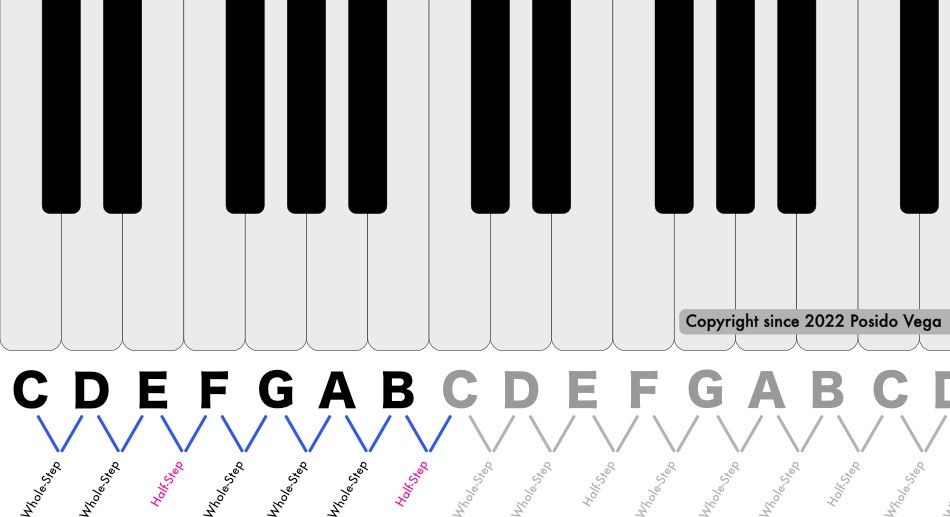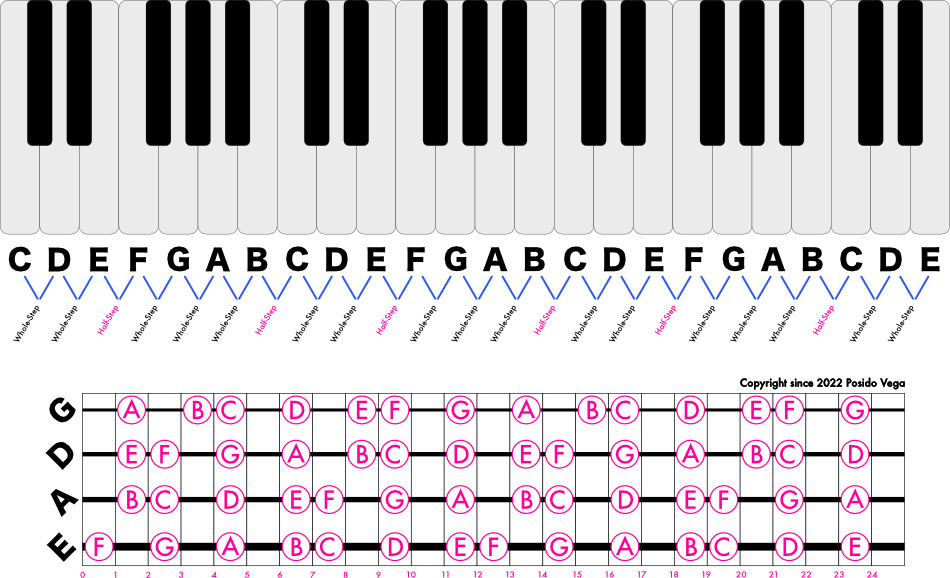Learning the notes on your bass guitar fretboard is a foundational skill that unlocks your musical potential. Many bassists, even those with years of experience, sometimes find themselves unsure of note locations across the neck. This shouldn’t be a barrier to your progress. Understanding your bass guitar notes doesn’t have to be a lengthy or daunting process. The fretboard operates on a logical system, and once you grasp this logic, navigating the notes becomes intuitive.
This guide is designed to provide you with a clear and effective method to learn your bass guitar notes quickly. We’ll break down the fretboard logic and provide you with a practical approach to mastering note recognition.
Step-by-Step Method to Learn Bass Guitar Fretboard Notes
The approach to learning all the notes on the bass guitar fretboard can be simplified into a structured, step-by-step method. This method emphasizes understanding the underlying logic rather than rote memorization, making the learning process more efficient and long-lasting.
Let’s delve into each step in detail, complete with diagrams and clear explanations.
For beginners or anyone struggling to memorize the fretboard, bookmark this page as a handy reference.
Quick Start Video Guide
If you prefer a visual and auditory learning experience, here’s a video that summarizes the step-by-step approach to learning the notes on your bass guitar.
 YouTube video
YouTube video
Learn Your Fretboard Bass Guitar Notes Fast! (4 Easy Steps)
Step 1: Understanding the Interval Logic of Musical Notes
In Western music, we primarily use 12 distinct notes. The key to quickly learning these notes is understanding their logical arrangement, which is based on musical intervals.
Tip: Musical notes follow an alphabetical sequence from A to G. If you know your alphabet, specifically A, B, C, D, E, F, and G, you’ve already grasped a significant part of the system.
These seven letters (A, B, C, D, E, F, G) represent the natural notes, also known as the white keys on a piano. This alphabetical sequence repeats itself across the musical spectrum: A, B, C, D, E, F, G, A, B, C, D, E, F, G, and so on.
The remaining five notes are the sharps and flats, often referred to as accidentals: A♯/B♭, C♯/D♭, D♯/E♭, F♯/G♭, and G♯/A♭. These correspond to the black keys on a piano and are positioned between the natural notes.
Notice that sharps and flats have dual spellings (enharmonic spelling). While they represent the same pitch, the spelling can vary depending on the musical context. For now, focus on recognizing the notes themselves; the nuances of spelling will become clearer as you progress.
Whole Steps and Half Steps Explained
Observe a piano keyboard. You’ll see black keys between most white keys, but there are two exceptions.
Tip: There is no black key between E and F, and no black key between B and C. This principle applies directly to the bass fretboard and guitar fretboard.
 Piano keys – Whole-Step and Half-Step Diagram
Piano keys – Whole-Step and Half-Step Diagram
Piano keys – Whole-Step and Half-Step Diagram
The interval between E and F is always a half-step (one fret on the bass). Similarly, the interval between B and C is also always a half-step (one fret).
All other natural notes are a whole-step apart, which translates to two frets on the bass guitar.
Let’s now apply this understanding to the bass fretboard itself. This approach is significantly more effective than trying to memorize notes in a chromatic (semitone by semitone) manner.
Step 2: Decoding the Bass Guitar Fretboard Logic
Building upon the previous step, remember these key points:
- Musical notes are alphabetically ordered.
- E-F and B-C are always a half-step apart.
- All other natural notes are a whole-step apart.
Here’s the crucial fretboard logic to internalize:
- Each fret on the bass fretboard represents a half-step.
- Two frets equal a whole-step.
On a standard four-string bass guitar, the open string notes are E, A, D, and G.
 Bass Guitar Fretboard Notes and Piano Notes Diagram
Bass Guitar Fretboard Notes and Piano Notes Diagram
Bass Guitar Fretboard Notes and Piano Notes Diagram
Let’s begin with the lowest string, the E string. Learning one string at a time is the most straightforward way to learn your bass guitar notes.
Recall that E-F and B-C are the only natural note pairs without a note in between.
Finding the Notes on Your E-String (Simple Method)
Starting with the open E string, the first fret up the neck is F. This is because E and F are a half-step apart.
Applying the logic of musical note intervals, we can map out the natural notes on the E string:
- Two frets up from F is G (whole step).
- Two frets up from G is A (whole step).
- Two frets up from A is B (whole step).
- One fret up from B is C (half step).
- Two frets up from C is D (whole step).
- Two frets up from D is E (whole step).
- The pattern then repeats itself in higher octaves.
Let’s apply this same method to the next string, the A-string.
Finding the Notes on Your A-String (Easy Guide)
Here are the natural note locations on the A-string:
- Two frets up from A is B (whole step).
- One fret up from B is C (half step).
- Two frets up from C is D (whole step).
- Two frets up from D is E (whole step).
- One fret up from E is F (half step).
- Two frets up from F is G (whole step).
- Two frets up from G is A (whole step).
- This pattern of notes repeats up the A string as well.
Continuing this process, let’s discover the natural notes on the D-string.
Finding the Notes on Your D-String (Quick Approach)
The natural note locations on the D-string are:
- Two frets up from D is E (whole step).
- One fret up from E is F (half step).
- Two frets up from F is G (whole step).
- Two frets up from G is A (whole step).
- Two frets up from A is B (whole step).
- One fret up from B is C (half step).
- Two frets up from C is D (whole step).
- And the pattern repeats again.
Just one more string to go! Let’s learn the bass guitar notes on the G-string.
Finding the Notes on Your G-String (Straightforward Way)
The natural note locations on the G-string are:
- Two frets up from G is A (whole step).
- Two frets up from A is B (whole step).
- One fret up from B is C (half step).
- Two frets up from C is D (whole step).
- Two frets up from D is E (whole step).
- One fret up from E is F (half step).
- Two frets up from F is G (whole step).
- This pattern continues to repeat up the G string.
Now, let’s accelerate your fretboard knowledge by learning about octaves.
Step 3: Utilizing Octave Shapes as Fretboard Landmarks
This step is crucial for rapidly expanding your fretboard knowledge. Octaves act as valuable “signposts” across the fretboard. While other intervals can serve a similar purpose, octaves are particularly useful for beginners because they represent the same note at a higher or lower pitch, minimizing confusion.
An octave is a perfect interval representing the same note at double or half the frequency.
For simplicity, there are numerous octaves available on your bass guitar fretboard. Identifying and learning their locations is a significant step forward.
Locate these octave shapes across the bass neck.
Bass Guitar Fretboard Octaves Diagram
Here are some easily memorizable octave shapes:
- Move two frets higher and up two strings: one octave higher.
- Move two frets lower and down two strings: one octave lower.
- Move three frets lower and up three strings: one octave higher.
- Move three frets higher and down three strings: one octave lower.
- Move five frets lower and up one string: one octave higher.
- Move five frets higher and down one string: one octave lower.
- Move seven frets higher and up one string: one octave higher.
- Move seven frets lower and down one string: one octave lower.
Step 4: Practical Application in Musical Contexts
While understanding the logic and octave shapes is essential, step 4, applying this knowledge in real musical situations, is what truly accelerates fretboard mastery.
Tip: There’s no substitute for practice. You need to play your bass and actively apply what you’re learning.
Consistent practice solidifies your knowledge, making note recognition become second nature and leading to faster fretboard mastery than you might expect.
In the video provided earlier, you’ll see how to apply these concepts using a simple bassline and a metronome for timing. A useful exercise is to play a bassline while consciously thinking about the root notes and their octave positions, then playing the same bassline an octave higher.
You’ll quickly realize how easily you can navigate and find notes on your fretboard with this approach.
(Bonus) Step 5: Verbalizing Note Names During Practice
An extremely effective bonus tip is to verbally name each note aloud as you practice.
Practice this slowly at first.
Prioritize accuracy over speed in this exercise.
This technique significantly reinforces note recognition and accelerates the learning process. A valuable practice method is to say the note name, locate the fret, and then play the note. When learning to read standard music notation, verbally spelling out note names reinforces their fretboard locations.
Incorporate this verbalization into your practice routines, band rehearsals, jam sessions, and even live performances. This allows for continuous learning in real-time playing scenarios.
This method forces you to think on your feet and was a great confidence builder during my early days of playing bass.
Your Turn to Practice and Explore
All the knowledge about fretboard logic and octave shapes becomes truly valuable when put into practice.
Learning your bass guitar notes is indispensable for improvisation, music reading, and playing along to chord charts while maintaining solid timing.
Start applying these steps, and you’ll experience noticeable progress in your fretboard knowledge within weeks.
For more bass guitar learning resources and content, explore additional materials and lessons available online.
Frequently Asked Questions
What are the Standard Bass Guitar Notes?
The standard tuning notes for a 4-string bass guitar, from lowest to highest string, are: E, A, D, and G.
For a 5-string bass, the notes are: B, E, A, D, and G.
For a 6-string bass, the notes are: B, E, A, D, G, and C.
Standard bass tuning utilizes intervals of fourths between strings. Understanding fourth intervals, similar to octaves, can be another helpful pattern for learning notes across strings.
What’s the Most Effective Way to Memorize Bass Guitar Notes?
A common question is, “How do I memorize all the notes on the bass?”
The most effective approach isn’t rote memorization, but rather understanding the underlying logic of note intervals and the fretboard layout. Once you grasp this logic, note locations become intuitive and make sense.
Develop good practice habits, such as recognizing patterns, utilizing octave shapes, and verbally naming notes. Trust the learning process.
Memorization becomes a natural byproduct of understanding the relationships and meaning behind the information you’re learning. Identifying patterns and shapes is a powerful method for establishing these mental connections.
How Do I Find Any Note on the Bass Guitar?
To find any note on your bass guitar, you need to understand the instrument’s fretboard. A 4-string bass in standard tuning has strings E, A, D, and G. The fretboard layout mirrors the logic of a piano keyboard. Natural notes are whole-steps apart, except for E and F (half-step) and B and C (half-step). All other natural notes are separated by a whole-step interval. By understanding these intervals and the open string notes, you can navigate to any note on the fretboard.

